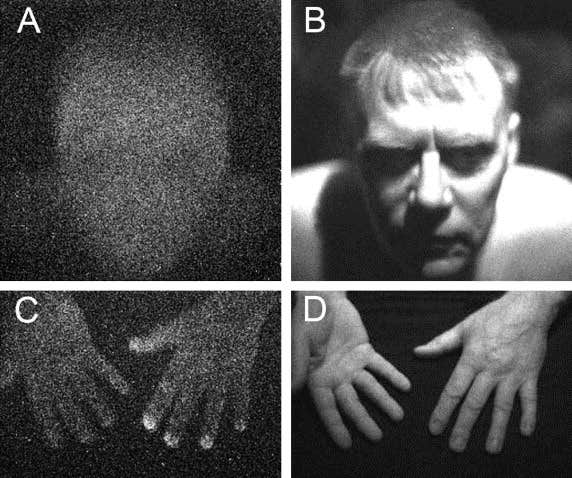Humans glow in a visible light that disappears in death, study finds
Discover how scientists captured life’s subtle glow—ultraweak photon emission—and its potential for health diagnostics and agriculture.

Ultra-weak photon emission of the face, the palm and dorsum of the hand. (CREDIT: ScienceDirect)
Life, in its quietest moments, glows gently—so subtly that it’s invisible to your eyes but bright enough for science to detect. Recently, researchers from the University of Calgary and the National Research Council of Canada captured this mysterious biological glow, known scientifically as ultraweak photon emission (UPE).
Their groundbreaking experiments revealed not just that life emits tiny amounts of light, but also how this glow fades sharply upon death, highlighting its potential as an innovative tool for understanding health, stress, and vitality.
Glowing Evidence of Life
Ultraweak photon emission, or biophoton emission, refers to very faint light produced by all living organisms—from plants and bacteria to humans. This emission is extremely subtle, involving just 10 to 1,000 photons per square centimeter every second.
For comparison, a common light bulb gives off billions upon billions of photons per second. Daniel Oblak, associate professor at the University of Calgary, clarifies, "We metabolize; we give off light. That does not imply anything else than we're producing energy."
Although biophoton emission has intrigued scientists for decades, its exact origin and purpose remain somewhat elusive. Scientists generally believe that this glow results from chemical reactions within cells—particularly involving molecules called reactive oxygen species (ROS). These molecules form naturally during metabolic processes, especially under stress or injury. When ROS interact with proteins or fats inside cells, electrons shift, releasing tiny bursts of light.
Capturing Life's Subtle Glow
To investigate biophoton emission clearly, researchers employed highly advanced imaging technology. Electron-multiplying charge-coupled device (EMCCD) and charge-coupled device (CCD) cameras—capable of detecting single photons—were used to observe living and dead mice, as well as plant leaves, under strictly controlled conditions. This approach eliminated interference from environmental light or heat.
Related Stories
In their study, published online in The Journal of Physical Chemistry Letters, four live mice were initially placed in complete darkness. Their faint glow was carefully recorded for an hour. After euthanasia, imaging continued for another hour, maintaining the animals' body temperature constant.
The results were stark: while living, mice emitted significantly more photons, primarily from their skin, compared to after death. According to researcher Vahid Salari, after death, "some organs still emit light, most likely from the liver," though this was less than 10 percent of the total emission observed when alive.
Plants Illuminate Under Stress
Similarly compelling results emerged from studies involving plants. Researchers tested leaves from thale cress and dwarf umbrella trees, subjecting them to stress through physical injury and chemical treatments. Injured areas consistently emitted brighter biophoton signals compared to untouched regions.
Remarkably, when benzocaine—a common anesthetic—was applied to injured leaves, researchers observed the most intense biophoton emissions, even exceeding those produced by hydrogen peroxide, a known stimulator of ROS.
This unexpected finding suggests that benzocaine interacts with cellular processes in a unique, yet unclear manner. Salari notes, "We still don’t know the main source. We have some speculation, like a sodium channel or the release of more reactive oxygen species."
Beyond Body Heat
One common misconception researchers addressed was whether this glow simply represented body heat. Oblak clarified that body heat, known as blackbody radiation, emits mostly infrared light—quite different from UPE. This study’s photons fell primarily in the visible range, clearly distinguishing them from ordinary thermal radiation.
Future Potential in Medicine and Agriculture
Though biophoton emission research is in its early stages, the findings hold tremendous promise. Since UPE correlates with metabolic and oxidative processes, it could serve as a non-invasive tool for early disease detection, including conditions like skin cancer. Additionally, it might help evaluate the health of transplant organs prior to surgery, potentially enhancing outcomes for patients.
The agricultural implications are equally exciting. Farmers might soon use drones equipped with photon-detecting cameras to monitor crop health. By detecting stressed plants early through their emitted photons, agricultural management could become more precise and effective. Riskin highlights, "It’s completely plausible that you’re going to have drones flying over fields measuring plant health."
Exploring Death and Vitality
Despite the eerie nature of observing life’s subtle glow fade after death, researchers emphasize that these findings aren't supernatural. Oblak reassures, "There’s a lot of metaphysical connotations to the glow, but it's not an energy field around us—it's biochemistry."
Understanding biophoton emission might redefine how scientists and medical experts measure health and vitality. The study’s authors are optimistic but cautious, acknowledging that significant research remains before practical applications become widespread.
"Now that we know there's a signal," Riskin notes, "we can create technologies to listen for that signal." Life’s glow, once a fringe curiosity, may soon illuminate our understanding of biological health in unprecedented ways.
Note: The article above provided above by The Brighter Side of News.
Like these kind of feel good stories? Get The Brighter Side of News' newsletter.



